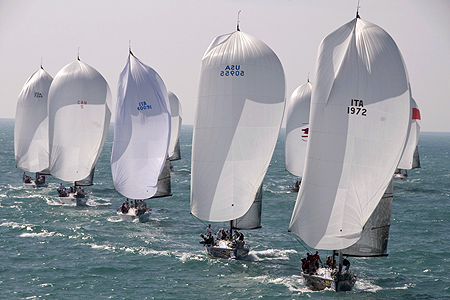
Pole forward looking for the fast line.
Another interesting post from the Australian sailing site, mysailing.com.au.
Figuring out how high to heat up your downwind angle is confusing. It feels better to get the boat moving, but after watching DORADO point right at the mark and get there first, and reading that if you’re having fun downwind you’re probably going too high, one starts to get the idea that finding the right angle might be more complicated. Here, Dave Flynn of Quantum Sails explains how the fastest downwind angle changes as pressure increases.
It can be useful to divide sailing downwind into three modes: under 10 knots true, 10-14, and over 14.
If you own a relatively standard mono-hull, the magic true wind angle is around 140 degrees in 10 knots of wind or less. In 10-14 the optimum angle quickly becomes broader, probably somewhere between 140 and 155 degrees true wind angle. Once there is more than 14 knots of breeze, you should be sailing as deep as you can with control.
The only exception to the rule is if your boat has a very high horsepower to weight ratio, in which case you may sail slightly tighter angles on average, and in 18-20 knots it will actually pay to head back up into the low 140’s. If your boat is light enough, it will begin to plane and surf in this much breeze.
Now what if you don’t have instruments capable of providing true wind angle? Notice, apparent wind angle was never referenced. This is because the optimum apparent wind angle changes rapidly with relatively small changes in wind speed. A typical displacement mono-hull will see the optimum apparent wind angle range from 90 to 130 degrees as the velocity increases from 4 to 10 knots. This makes the apparent wind angle simply too volatile to be useful. The true wind angle remains virtually constant over this same range; hence, its power.
In the middle range (10-14 knots) both apparent and true wind change quickly. In this area, it pays to get back to basics and only rely on the pressure on the spinnaker sheet and helm as a guide. The game downwind is all about constant pressure. The more constant, the less overall pressure you will need to maintain speed.
Eventually, the pole will be able to be squared back and the boat sailed at broad angles without losing pressure. Usually, above 14 knots, it pays to concentrate on sailing as deep as control will allow. The boat is no longer going to sail much faster by heading up.